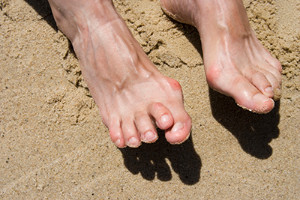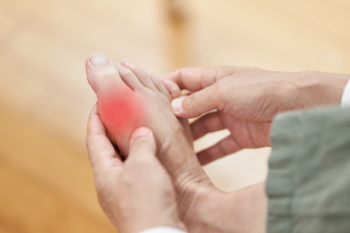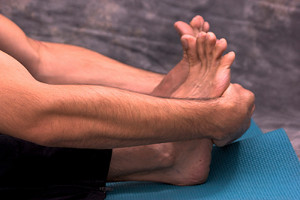Items filtered by date: May 2024
Why Some People Get Hammertoes

Hammertoes are a deformity where the toe bends at the middle joint, causing the tip to curl downward, resembling a hammer. This condition can affect any of the smaller toes and is categorized into flexible hammertoes, which are still movable at the joint. Rigid hammertoes are defined as tight tendons causing the joint to become misaligned and immobile. Hammertoes develop over time, often due to wearing ill-fitting shoes that squeeze the toes or cause them to bend. High heels or narrow shoes are common culprits. Genetics, certain diseases like arthritis, and trauma can also contribute to their formation. People with unusually long toes, flat feet, or high arches are more susceptible. Diagnosis typically involves a physical examination, and in some cases, X-rays to assess the extent of the deformity. Treatment options range from changes in footwear and custom orthotic devices to surgery in severe cases. If you have a hammertoe that is causing you discomfort, it is suggested that you visit a podiatrist for an accurate diagnosis and treatment options.
Hammertoes can be a painful condition to live with. For more information, contact Dr. Joshua David Scoll of Pennsylvania. Our doctor will answer any of your foot- and ankle-related questions.
Hammertoe
Hammertoe is a foot deformity that occurs due to an imbalance in the muscles, tendons, or ligaments that normally hold the toe straight. It can be caused by the type of shoes you wear, your foot structure, trauma, and certain disease processes.
Symptoms
- Painful and/or difficult toe movement
- Swelling
- Joint stiffness
- Calluses/Corns
- Physical deformity
Risk Factors
- Age – The risk of hammertoe increases with age
- Sex – Women are more likely to have hammertoe compared to men
- Toe Length – You are more likely to develop hammertoe if your second toe is longer than your big toe
- Certain Diseases – Arthritis and diabetes may make you more likely to develop hammertoe
Treatment
If you have hammertoe, you should change into a more comfortable shoe that provides enough room for your toes. Exercises such as picking up marbles may strengthen and stretch your toe muscles. Nevertheless, it is important to seek assistance from a podiatrist in order to determine the severity of your hammertoe and see which treatment option will work best for you.
If you have any questions, please feel free to contact one of our offices located in Philadelphia, Bensalem, and Fairless Hills, PA . We offer the newest diagnostic and treatment technologies for all your foot care needs.
Essential Insights to Know about Gout

Gout, often termed the disease of kings, is a form of inflammatory arthritis caused by the accumulation of uric acid crystals in the joints, leading to intense pain and swelling. Contrary to popular belief, gout can affect anyone, regardless of social status or dietary habits. The condition typically manifests in sudden, severe attacks, commonly affecting the big toe. Factors contributing to gout include genetics, a diet rich in purines that are found in red meat, seafood, and alcohol, obesity, and certain medical conditions like hypertension or kidney disease. Despite its historical association with indulgence, gout is a legitimate medical concern that requires proper management and treatment. Without intervention, recurrent gout attacks can lead to joint damage and chronic pain, significantly impacting one's quality of life. If you have severe pain in your big toe and surrounding areas, it is strongly suggested that you seek advice from a podiatrist who can help you find relief and management methods.
Gout is a painful condition that can be treated. If you are seeking treatment, contact Dr. Joshua David Scoll from Pennsylvania. Our doctor will treat your foot and ankle needs.
What Is Gout?
Gout is a form of arthritis that is characterized by sudden, severe attacks of pain, redness, and tenderness in the joints. The condition usually affects the joint at the base of the big toe. A gout attack can occur at any random time, such as the middle of the night while you are asleep.
Symptoms
- Intense Joint Pain - Usually around the large joint of your big toe, and it most severe within the first four to twelve hours
- Lingering Discomfort - Joint discomfort may last from a few days to a few weeks
- Inflammation and Redness -Affected joints may become swollen, tender, warm and red
- Limited Range of Motion - May experience a decrease in joint mobility
Risk Factors
- Genetics - If family members have gout, you’re more likely to have it
- Medications - Diuretic medications can raise uric acid levels
- Gender/Age - Gout is more common in men until the age of 60. It is believed that estrogen protects women until that point
- Diet - Eating red meat and shellfish increases your risk
- Alcohol - Having more than two alcoholic drinks per day increases your risk
- Obesity - Obese people are at a higher risk for gout
Prior to visiting your podiatrist to receive treatment for gout, there are a few things you should do beforehand. If you have gout you should write down your symptoms--including when they started and how often you experience them, important medical information you may have, and any questions you may have. Writing down these three things will help your podiatrist in assessing your specific situation so that he or she may provide the best route of treatment for you.
If you have any questions, please feel free to contact one of our offices located in Philadelphia, Bensalem, and Fairless Hills, PA . We offer the newest diagnostic and treatment technologies for all your foot care needs.
How Stretches Can Keep Your Toes Healthy

Your toes might seem like small, inconsequential parts of your body, but when they're happy and healthy, they play a big role in your overall comfort and mobility. Fortunately, you don't need fancy equipment or hours of time to keep your toes in tip-top shape. Just a few simple toe stretches can go a long way in promoting flexibility, strength, and comfort. Stretching your toes is about promoting blood flow, reducing pain and swelling, and minimizing your risk of injury. Start with both feet flat on the floor, then lift your toes, aiming to get them all to the same height. Hold for a few seconds, then repeat. Similar to the toe lift, but this time, try to spread your toes apart as much as possible while lifting. Stand next to a wall and use your hands for support as you press your toes against the wall, flexing them gently. Wrap a towel or belt around your big toe and gently pull it toward you to increase mobility. Using a wall for support, push the toes of one foot against the floor to stretch them. While these stretches can work wonders for many people, it's essential to listen to your body and consult with a podiatrist if you experience persistent pain or discomfort. They can offer personalized advice and treatment options to keep your feet happy and healthy for years to come. Incorporating these simple toe stretches into your daily routine takes just a few minutes but can make a world of difference in how your toes feel and function. If you are experiencing any type of toe pain, it is suggested that you make an appointment with a podiatrist.
Why Stretching Is Important for Your Feet
Stretching the feet is a great way to prevent injuries. If you have any concerns with your feet consult with Dr. Joshua David Scoll from Pennsylvania. Our doctor will assess your condition and provide you with quality foot and ankle treatment.
Stretching the Feet
Stretching the muscles in the foot is an important part in any physical activity. Feet that are tight can lead to less flexibility and make you more prone to injury. One of the most common forms of foot pain, plantar fasciitis, can be stretched out to help ease the pain. Stretching can not only ease pain from plantar fasciitis but also prevent it as well. However, it is important to see a podiatrist first to determine if stretching is right for you. Podiatrists can also recommend other ways to stretch your feet. Once you know whether stretching is right for you, here are some excellent stretches you can do.
- Using a foam roller or any cylindrical object (a water bottle or soda can will do), roll the object under your foot back and forth. You should also exert pressure on the object. Be sure to do this to both feet for a minute. Do this exercise three times each.
- Similar to the previous exercise, take a ball, such as a tennis ball, and roll it under your foot while seated and exert pressure on it.
- Grab a resistance band or towel and take a seat. If you are using a towel, fold it length wise. Next put either one between the ball of your foot and heel and pull with both hands on each side towards you. Hold this for 15 seconds and then switch feet. Do this three times for each foot.
- Finally hold your big toe while crossing one leg over the other. Pull the toe towards you and hold for 15 seconds. Once again do this three times per foot.
It is best to go easy when first stretching your foot and work your way up. If your foot starts hurting, stop exercising to ice and rest the foot. It is advised that you then see a podiatrist for help.
If you have any questions, please feel free to contact one of our offices located in Philadelphia, Bensalem, and Fairless Hills, PA . We offer the newest diagnostic and treatment technologies for all your foot care needs.
Why Live with Pain and Numbness in Your Feet?
Various Types of Foot Protection at Work

In the realm of workplace safety, protecting one's feet is vital to prevent injuries and ensure productivity. Several types of foot protection options cater to diverse work environments and hazards. Safety shoes, featuring reinforced toe caps and slip-resistant soles, provide basic protection against impacts and slips in various industries. Steel-toed boots offer enhanced durability and impact resistance, making them ideal for construction and heavy-duty environments. Metatarsal guards add an extra layer of defense by protecting the delicate bones in the midfoot region from crushing or impacts. For workers exposed to electrical hazards, specialized footwear provides insulation against electrical currents, reducing the risk of shock or electrocution. Each type of foot protection serves a unique purpose, tailored to specific workplace risks and requirements. If you have injured your foot while working, and are looking to learn more about what type of shoes to purchase for total foot protection, it is suggested that you visit a podiatrist who can offer treatment and provide you with the information you are seeking.
While working on the feet, it is important to take the proper care of them. For more information about working on your feet, contact Dr. Joshua David Scoll from Pennsylvania. Our doctor will treat your foot and ankle needs.
Working on Your Feet
Standing on your feet for long periods of time can cause stress and pain in your feet. Your whole body may experience change in terms of posture, back pain, bunions, callouses and or plantar warts. There are ways to avoid these conditions with proper foot care, smart choices and correct posture.
Positive Changes
Negative heeled shoe – Choosing this shoe type places the heel slightly lower than the ball of the foot. These are great for overall foot health. Find shoes that fit you correctly.
Go barefoot – Our feet were not designed to be enclosed for all hours of the day. Try to periodically expose your feet to air.
Eliminate Pain
Foot Exercises – Performing simple exercises, incorporating yoga and doing stretches are beneficial. This will allow increased blood flow to the area and muscles of the foot.
Achilles tendon – Stretching the foot out flat on the floor will relax the calf muscles and tendon. These exercises can be performed almost anywhere. Make sure you add these exercises to your daily regimen.
With a little bit of this information and knowing more about foot health, you will notice changes. Foot stretches and proper footwear will help with pain and prevent further issues.
If you have any questions please feel free to contact one of our offices located in Philadelphia, Bensalem, and Fairless Hills, PA . We offer the newest diagnostic and treatment technologies for all your foot and ankle needs.

